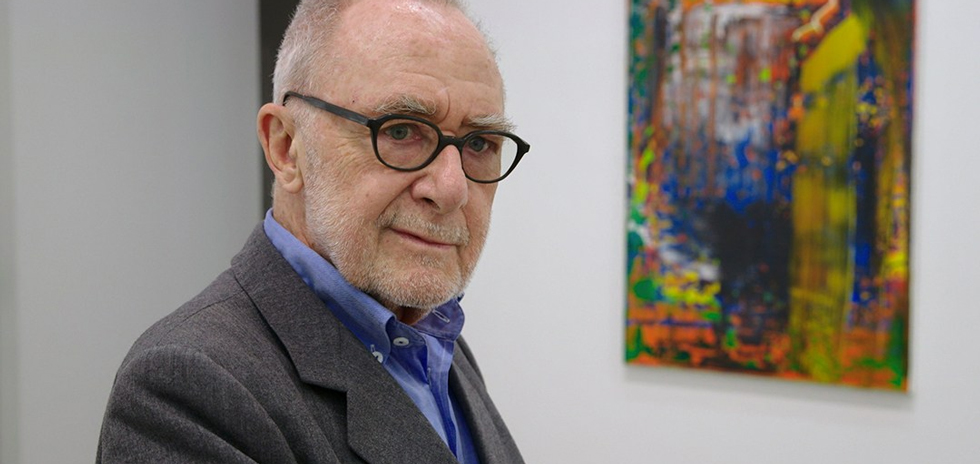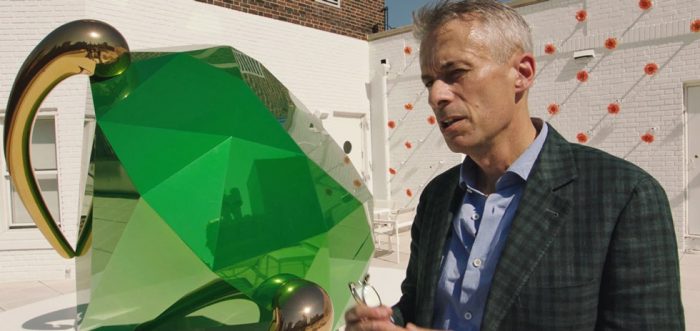This review is published in partnership with Melbourne International Film Festival’s Critics Campus program.

The art auction at Sotheby’s hums like a symphony—it is a layered, dramatic, but meticulous affair. Under the non-diegetic mania of Saint-Saëns’ Danse Macabre, auctioneers shift and gesticulate like orchestra conductors, announcing rapidly increasing millions, barely pausing for breath. The modern-day demimonde raise hands and point and talk on telephones as paintings and sculptures climb to peaks of unaffordability, each sale ending on one final satisfying cadence— a blue-suited auctioneer slams his gavel down on the podium, and presto: someone has just swapped 52 million USD for what appears to be, as per the flattened image on the projector, an inflated balloon dog.1 The crowd erupts in rapturous applause. These fleet-footed opening moments of Nathaniel Kahn’s documentary The Price of Everything set the focus for the rest of the film, a surface-level farce of the contemporary art market which never truly breaks away.
Kahn treads typical art-doc grounds, skidding over a Guess Who line-up of art-world-aficionados, achieving less a thesis than a spectacle—a particular brand of confusion that appears to infuse everyone with a sense of imposter syndrome. “Is it art?” our interviewer asks collector Stefan Edlis of what looks like a rubber foot, sticking out of a mound of bread.2 “Well, it’s not food,” is the reply. Art, itself, is impenetrable, and so are, it seems, its processes. Kahn himself expresses the trouble in finding clarity when navigating an endlessly complex and multifarious world of high-end sellable art. Describing his approach to this film, he says, “There could be a million ways of doing it. Where do you possibly start?” He answers his own question: “Start shooting.”
What this aimless shooting captures is a dense social, economic, and psychological indictment of the unavoidable consolidation between the intrinsic and the financial value of art. Loosely structured around the chronological lead-up to the 2016 Sotheby’s Fall Auction, Kahn digresses wildly, from Sotheby’s Exec VP Amy Cappellazzo’s administrative tasks to Stefan Edlis’ trading system to George Condo on a ladder, sweeping a black oil stick to draw a single hair on a work that is sure to be worth hundreds of thousands.3 In this way, The Price of Everything is almost the antithesis to Frederick Wiseman’s constrained behind-the-scenes art museum documentary National Gallery; if National Gallery were thrown into a leaf-blower, though, the results might be similar.
Through a shaky, precarious lens, Kahn presents us with a series of artists, dealers, auctioneers, collectors, and critics, incessantly circling the intersection of art and commerce. They are inseparable, “like Siamese twins”, says art dealer Gavin Brown. They have always gone “hand in hand”, says Simon de Pury, an art auctioneer and collector. A description of artist Jeff Koons’ previous sales-based vocation is spliced with a phone-sale scene from Scorsese’s The Wolf of Wall Street. At times, the film gives the impression of a broken record.

While betraying little originality of content, The Price of Everything does offer something more holistic and pragmatic than the steady stream of profile-based TV-ready art documentaries produced over the past decade. Kahn attempts, in part, to shed some light on the unwritten rules of the game, or perhaps, just to outline the game itself. What becomes quickly apparent, though, is that the film is near identical in subject-matter to Barry Avrich’s more structurally cohesive 2017 documentary Blurred Lines: Inside the Art World, which splits much of the same material into logical categories—artists, collectors, auction houses, etc. While Avrich, who calibrates dialogue through careful questioning and provides historical and economic contextualization, hovers broadly above this universe, Kahn dives straight into the midst of it. He directs with the same, intimate energy necessary for a biopic, drawing on his previous creative-profile films such as My Architect (a posthumous portrait of his father, architect Louis Kahn) and Two Hands: The Leon Fleisher Story, that seek more to portray his subject, than to explain them. This film largely bypasses talking heads: interviewees are in constant action, fondling coffee-table hardbacks, scanning an excel spreadsheet, having a coffee in the backseat of a car. This thickness of immersion does not demystify—in fact, the film clouds as it progresses. In a documentary such as Blurred Lines, the process may be explicably unpredictable, but here, in true, cinematic form, Kahn’s filmic reality thrives in its lack of self-awareness. Subjects are not unaware of being filmed, but of being in a film—a documentary, no less. These people talk but do not illuminate; they complain but do not resolve—they are oblivious of their roles, to the layman, as informational gatekeepers of this airtight world.
Despite the opacity of the art market, Kahn believes “that there really is something in art that transcends money, that twists free of commerce and that, at its best, points the way towards some kind of enlightenment.” However, the commerce-heavy focus of his film leads away from this ideal and into a corner of deep cynicism. Here, the true worth of art remains unarticulated. This becomes The Price of Everything’s inadvertent message, and a dilemma that Kahn becomes largely guilty of circumventing. The value of art, when detached from commerce, dissolves into a series of subjective, ambiguous abstractions. In one moment in the film, Phillips CEO Ed Dolman says, “There are people who know the price of everything and the value of nothing.” But how can this value ever be quantified, if not financially? Kahn’s avoidance of this inquiry, overlooking any rationalization for artistic worth, counteracts the film’s indictment on how the value of art has become prescribed largely by its financial cost. By focusing solely on this problem, and offering no resolution to his own critique, Kahn gives no indication as to whether art can be, ultimately, inseparable from commerce.
The Price of Everything will play at the Antenna Documentary Film Festival in Sydney on 13 October.
